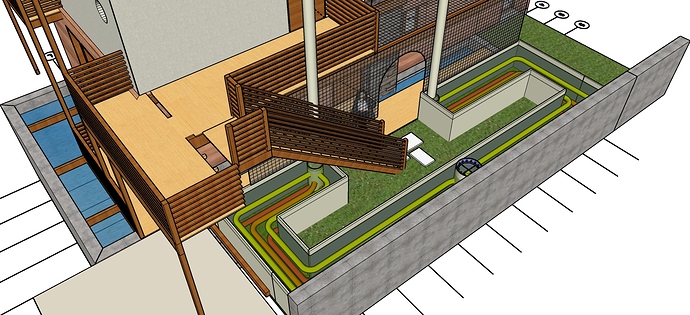When a greenhouse is in full sun, the climate battery uses simple fans to pump warm, moist air through a network of flexible air tubes buried in the soil beneath the plants, storing that excess heat and humidity in the soil for later use, while cooling and dehumidifying the greenhouse. This is a low-tech form of fan-assisted passive solar heating and cooling, known to support Mediterranean and Tropical perennials in a high alpine Rocky Mountain climate.
Central Rocky Mountain Permaculture Institute
Eco Systems Design, Inc.
Thanks Michael!
Michael and his colleague are from Colorado and Jerome Osentowski is a seasoned permaculturalist and founder of CRMPI, the Central Rocky Mountain Permaculture Institute. He has written an awesome book called the FOREST GREENHOUSE GARDEN, which I am implementing in our own showcase ecohome.
This is a nexus, circular design that integrates Water-Energy-Food-Waste all into the same holistic strategy. With such a greenhouse, we plan to grow a 7 layer succession food forest for urban food independence but use the sun and soil for natural passive HVAC. Jerome has done this successfully in the cold of Colorado but it can be adapted to many colder regions of the planet. Here in Cape Town, we have a Mediterranean climate but with the greenhouse, we can grow tropical fruits as well.
Hi Gien, It looks like your hackathon was well attended, with a lot of ideas to review. Here is an image of the suggestions I made in an earlier email, regarding a raised bed battery for heat storage, and a vertical and horizontal trellis along the south edge of the beds. This will require some space between the balcony and the stair down to the greenhouse, for the bed battery intake risers, here shown at 30.cm dia, as well as to allow space for plants to climb the trellis behind the stair.
For those reading this, with questions about the bed battery, it is a simple heat and humidity exchange system, between the greenhouse air and the planting bed soil in which the network of perforated tubing is buried. Warm humid air is circulated from high in the greenhouse, through the network of tubing, which stores heat and moisture in the soil. When the greenhouse requires heat at night, cooler air is circulated through the network, returning to the greenhouse warmer and more humid.
Thanks, Gien!
Michael
Oh hey Michael,
When you click to post a message, there is an icon on the top menu bar of your word editor, which is 7th from the left that looks like an UP arrow siting on a horizontal line. But let me upload this time.
Thanks! I had to try it, so now I can upload images for discussion.
Michael
I just came across a book which might add to this discussion - https://www.milkwood.net/2018/02/27/retrosuburbia-the-downshifters-guide-to-a-resilient-future/
I assume you already know about Regen Villages?
@MPThompson is the bed battery passive or driven? If driven (which it sounds like) can part of the cycle be passive?
Hi @William,
I just discussed the Bed Battery with Michael. It’s too narrow for the house and doesn’t leave much room for growing a food forest! We have decided to bury the ventilation pipes instead.
The Bed Battery saves on trenching but severely limits the indoor growing space so I decided it’s better to opt for more trenching.
Michael will upload the new revised drawings.
Thanks @MPThompson,
So this is instead of burying it in the ground itself? What is the advantage of a raised bed climate battery? I would rather bury all the ventilation piping in the soil so I can have more room for the ground surface of the greenhouse itself. Does Jerome usually use the surface soil space above the ventilation piping to plant parts of the successional food forest such as other trees, etc?
